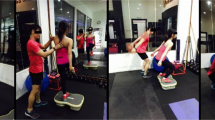Abstract
In this article, we focus on fitness workout scenarios. To examine the current practices, we first conducted a substantial user research, through the content analysis procedure we summarized insights regarding fitness purpose, essential data, psychological state, emotional changes and social habits. Subsequently, we generalized related design opportunities of improving the fitness experience and motivation to enhance the fitness performance and communication. Feedback and data representation have great potential to address the challenges, therefore we first proposed a design process for the feedback mode design of fitness workout, including the contextual information, feedback strategy, and realization ways. The feedback designs are implemented on a wearable augmented feedback system ‘FitSleeve’, focusing on individual and group scenarios separately. In group sessions, FitSleeve can demonstrate participants’ experience level, real-time heart rate zone and feedback regarding the correct movement execution. In individual sessions, FitSleeve can display the training progress and provide continuous encouragement. Finally, we evaluated FitSleeve by adopting the System Usability Scale, User Experience Questionnaire, Intrinsic Motivation Inventory and user subjective interviews. The findings indicate the potential of FitSleeve to improve the user experience and motivation of fitness participants.
Access this chapter
Tax calculation will be finalised at checkout
Purchases are for personal use only
Similar content being viewed by others
References
Amini, F., Hasan, K., Bunt, A., Irani, P.: Data representations for in-situ exploration of health and fitness data. In: Proceedings of the 11th EAI International Conference on Pervasive Computing Technologies for Healthcare - PervasiveHealth 2017, pp. 163–172 (2017)
ten Bhömer, M., Du, H.: Designing personalized movement-based representations to support yoga. In: Proceedings of the 2018 ACM Conference Companion Publication on Designing Interactive Systems, pp. 283–287 (2018)
Genç, Ç., Ekmekçioğlu, Y.A., Balci, F., et al.: Howel: a soft wearable with dynamic textile patterns as an ambient display for cardio training. In: Extended Abstracts of the 2019 CHI Conference on Human Factors in Computing Systems, pp. 1–6 (2019)
Clermont, C.A., Duffett-Leger, L., Hettinga, B.A., Ferber, R.: Runners’ perspectives on ‘smart’ wearable technology and its use for preventing injury. Int. J. Hum. Comput. Interact. 36(1), 31–40 (2020)
Esakia, A., McCrickard, D.S., Harden, S., Horning, M.: FitAware: promoting group fitness awareness through glanceable smartwatches. In: GROUP 2018: Proceedings of the 2018 ACM Conference on Supporting Groupwork, Sanibel Island, FL, USA, 7–10 January 2018, pp. 178–183 (2018)
Goudswaard, M., Abraham, A., da Rocha, B.G., Andersen, K., Liang, R.-H.: FabriClick: interweaving pushbuttons into fabrics using 3D printing and digital embroidery. In: DIS 2020: Proceedings of the 2020 ACM Designing Interactive Systems Conference, Eindhoven, Netherlands, 6–10 July 2020, pp. 379–393 (2020)
Hsieh, H.-F., Shannon, S.E.: Three approaches to qualitative content analysis. Qual. Health Res. 15(9), 1277–1288 (2005)
Intrinsic Motivation Inventory (IMI): Selfdeterminationtheory.org. http://selfdeterminationtheory.org/. Accessed 5 June 2021
Vidal, L.T., Segura, E.M., Boyer, C., et al.: Enlightened yoga: designing an augmented class with wearable lights to support instruction. In: Proceedings of the 2019 on Designing Interactive Systems Conference, pp. 1017–1031 (2019)
Mauriello, M, Gubbels, M., Froehlich, J.E.: Social fabric fitness: the design and evaluation of wearable e-textile displays to support group running. In: Proceedings of the SIGCHI Conference on Human Factors in Computing Systems, Toronto, Canada, pp. 2833–2842 (2014)
Morris, D., Saponas, T.S., Guillory, A., Kelner, I.: RecoFit: using a wearable sensor to find, recognize, and count repetitive exercises. In: Proceedings of the SIGCHI Conference on Human Factors in Computing Systems, Toronto, Canada, pp. 3225–3234 (2014)
Page, E.J., Massey, A.S., Prado-Romero, P.N., Albadawi, S.: The use of self-monitoring and technology to increase physical activity: a review of the literature. Perspect. Behav. Sci. 43(3), 501–514 (2020). https://doi.org/10.1007/s40614-020-00260-0
Ploderer, B., et al.: ArmSleeve: a patient monitoring system to support occupational therapists in stroke rehabilitation. In: DIS 2016: Proceedings of the 2020 ACM Designing Interactive Systems Conference, Brisbane, Australia, pp. 700–711 (2016)
Schrepp, M., Hinderks, A., Thomaschewski, J.: Construction of a benchmark for the user experience questionnaire. Int. J. Interact. Multimedia Artif. Intell. 40–44 (2017)
Tanaka, H., Monahan, K.D., Seals, D.R.: Age-predicted maximal heart rate revisited. J. Am. Coll. Cardiol. 3(1), 153–156 (2001)
Vidal, L.T., Zhu, H., Riego-Delgado, A.: BodyLights: open-ended augmented feedback to support training towards a correct exercise execution. In: Proceedings of the 2020 CHI Conference on Human Factors in Computing Systems, pp. 1–14 (2020)
Walmink, W., Wilde, D., Mueller, F.F.: Displaying heart rate data on a bicycle helmet to support social exertion experiences. In: Proceedings of the 8th International Conference on Tangible, Embedded and Embodied Interaction, pp. 97–104 (2014)
Woźniak, P., Knaving, K., Björk, S., et al.: RUFUS: remote supporter feedback for long-distance runners. In: Proceedings of the 17th International Conference on Human-Computer Interaction with Mobile Devices and Services, pp. 115–124 (2015)
Acknowledgment
This work is supported by Shanghai Yangfan Youth Talented Program [grant number 20YF1451200].
Author information
Authors and Affiliations
Corresponding author
Editor information
Editors and Affiliations
Rights and permissions
Copyright information
© 2022 The Author(s), under exclusive license to Springer Nature Singapore Pte Ltd.
About this paper
Cite this paper
Wang, Q., Li, Z., Guo, W., Sun, X. (2022). FitSleeve: Designing Wearable Display and Feedback to Improve the Fitness Experience and Motivation. In: Bruyns, G., Wei, H. (eds) [ ] With Design: Reinventing Design Modes. IASDR 2021. Springer, Singapore. https://doi.org/10.1007/978-981-19-4472-7_198
Download citation
DOI: https://doi.org/10.1007/978-981-19-4472-7_198
Published:
Publisher Name: Springer, Singapore
Print ISBN: 978-981-19-4471-0
Online ISBN: 978-981-19-4472-7
eBook Packages: Literature, Cultural and Media StudiesLiterature, Cultural and Media Studies (R0)




